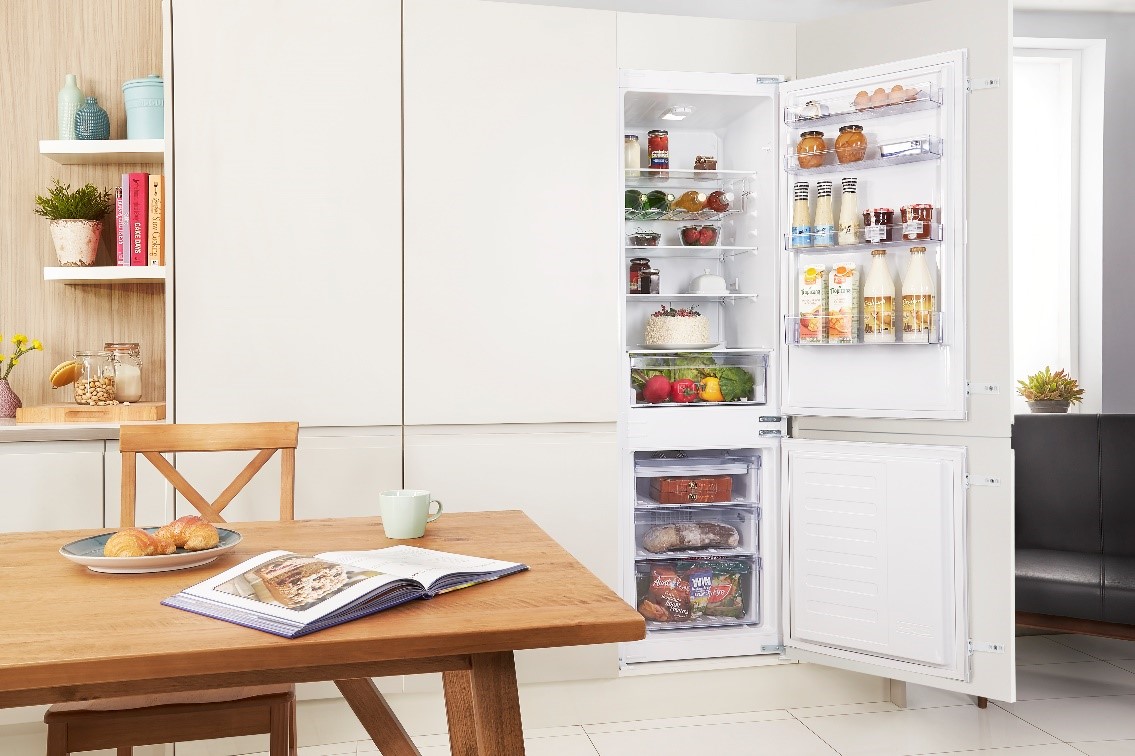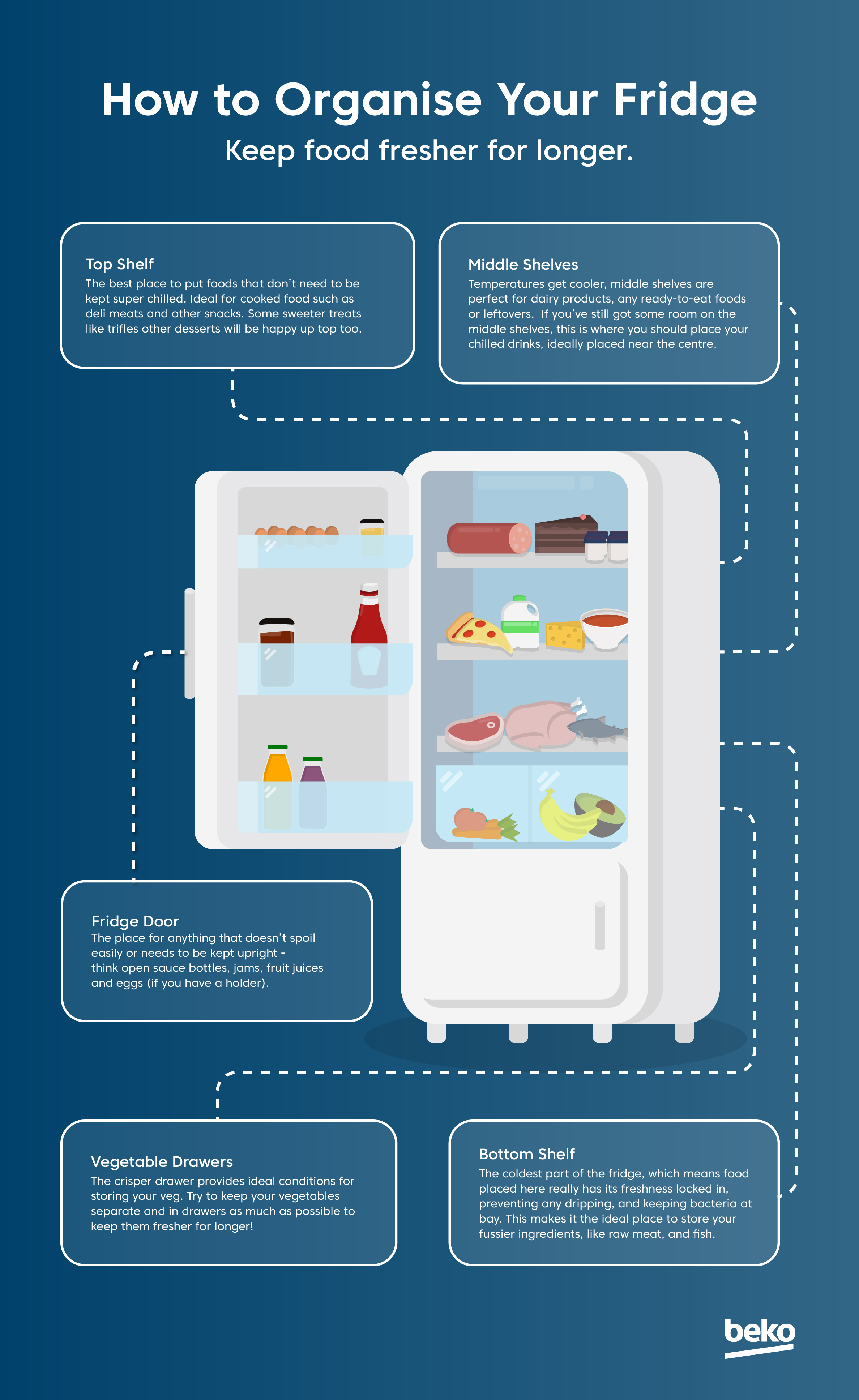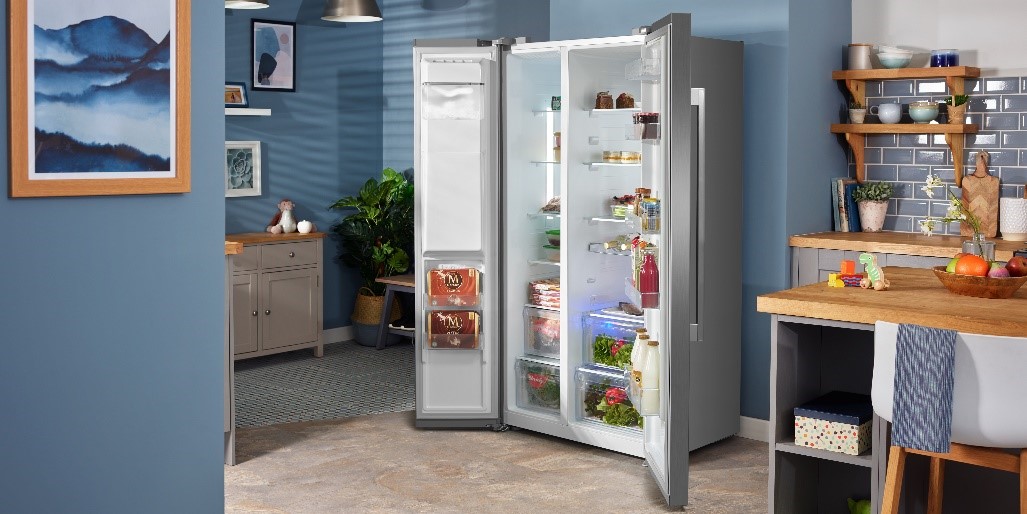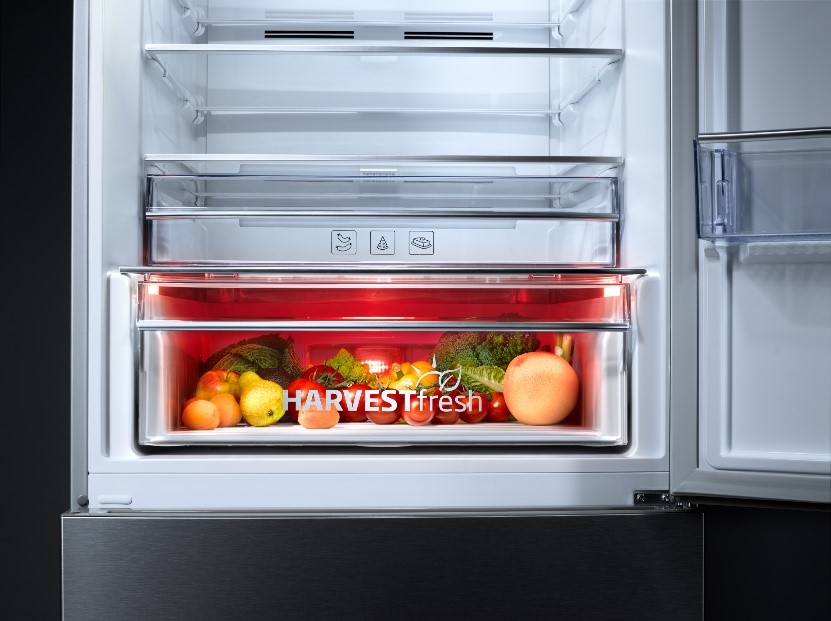How to organise a fridge
Each year, UK households throw away 6.6 million tonnes of food, of which 4.5 million tonnes is edible[1]. One of the best ways to reduce food waste is to ensure that your fridge is organised correctly. By organising your fridge effectively, you’ll be able to see everything you have purchased, meaning you’ll know what needs eating and when!
To help you keep your food fresher for longer, we’ve pulled together a handy guide that explains how to organise your fridge correctly. You remember playing Tetris? It’s a bit like that, but with your weekly shop.

Why is fridge organisation important?
It is important to know how to organise your refrigerator properly. By understanding how a fridge should be organised, you can ensure your food is kept food fresher for longer, whilst retaining the quality of your groceries. Our range of innovative fridges and fridge freezers are designed with dedicated zones to help you correctly arrange your fridge, such as large salad crisper drawers, chrome wire wine racks, and chiller compartments. In addition to this, our range of fridges feature advanced technologies designed to keep your food fresher for longer, like HarvestFresh™, which preserves the vitamins in your fresh fruit and veg in the crisper drawer.
How to arrange your fridge
When you’ve done your weekly shop and your bags are bulging with cheese, meat, and veg, you’re inevitably faced with the challenge of trying to juggle and squeeze all those goodies into the fridge.
To help you answer the age-old question of ‘how should a fridge be organised’, we’ve pulled together our top fridge organisation tips. Before we get started, it is worth noting that our recommendations are based on standard fridges and that recommendations will vary depending on what size and function your fridge are used for (don’t go reorganising the office fridge just to cram in your shopping!). For a standard fridge, here are our suggestions on how to organise a fridge at home:

How to organise the top of a fridge
The top shelf is the part of the fridge that is not as cold, so this is the best place to put foods that don’t need to be kept super chilled, such as food that is already cooked. This part of the fridge is ideal for food such as deli meats and other snacks. Some sweeter treats like trifles other desserts will be happy up top too.
How to organise fridge shelves
As you move down the fridge, temperatures get cooler. The middle section of your fridge is a great place for any dairy products, ready-to-eat foods and leftovers – like that Saturday night pizza.
Wondering how to organise drinks in your fridge? If you’ve still got some room on the middle shelves this is where you should place your chilled drinks, ideally near the centre. Alternatively, if you have a fridge freezer with a wine rack, the middle shelf is where the rack should sit for optimum chilling. A selection of Beko’s fridges and fridge freezers feature dedicated wine racks, offering a safe and convenient place to store your wine bottles and soft drinks.
How to organise the bottom of your fridge
The bottom shelf of the fridge is the coldest part, which means food placed here really has its freshness locked in, preventing any dripping, and keeping bacteria at bay. This makes it the ideal place to store your fussier ingredients, like raw meat and fish. A selection of our fridges and fridge freezers feature dedicated chiller compartments that offer a hygienic and perfectly suited environment for your meat, fish, and dairy products. By maintaining a temperature at around 0 degrees Celsius, this innovative compartment helps keep food fresher for longer.
How to organise vegetables in a fridge
The crisper drawer provides ideal conditions for preserving vegetables and fruits. Our refrigerators are actually designed to keep your food fresher for longer thanks to innovative technology like HarvestFreshTM, which helps you to enjoy a healthier lifestyle, with more nutritious meals than ever. Using three-colour light technology, HarvestFres™ mimics the sun’s natural 24-hour light cycle, preserving the vitamins in your fruit and veg for up to five additional days.
Top tip: To keep your vegetables fresher for longer, try to keep your vegetables separate and in the crisper drawer as much as possible! Separate avocados, bananas, tomatoes, and other ripening fruits from the rest of your produce, as these fruits produce ethylene, which speeds up the ripening of other foods, causing rot.
How to organise a fridge door
And last, but not least, your fridge doors are really the place for anything that doesn’t spoil easily or needs to be kept upright - think open sauce bottles, jams, fruit juices and, definitely your eggs (if you have a holder) – as those are known for their tendency to roll off the shelf when you least expect it!
How to organise a fridge correctly

When stocking up your fridge, make sure that you are not over packing the appliance and that you are leaving enough room for air to circulate around the fridge’s interior. If your fridge is crammed with groceries, cold air will not be able to circulate, meaning temperatures will vary and bacteria could grow. Keeping your fridge at the correct temperature is the best way to ensure your food is kept fresh and hygienic. If the temperature of your fridge is too high, harmful bacteria and micro-organisms can start to grow at an increased rate.
The best ways to keep food fresher for longer

You now have your plan ready for how you want to put your food in the fridge, so it’s time to narrow in on how to preserve freshness for as long as possible, to reduce waste.
Tips for preserving food for longer:
- Separate your vegetables.. As we mentioned above, keeping several ripening fruits and vegetables together produces a gas called ethylene, which is responsible for causing other fruit and vegetables nearby to ripen faster and begin to rot sooner. The following fruits and vegetables should be stored separately: apples, asparagus, avocados, bananas, broccoli, brussels sprouts, carrots, cauliflower, cucumber, lettuce, mangoes, onions, pears, plums, potatoes, pumpkin, tomatoes, and strawberries.
- Store salad in containers. You can keep salad fresher for longer by poking holes in the top of the container you keep it in.
- Absorb vegetable moisturePutting a dry paper towel in the veg box helps to absorb the moisture that the veggies create, helping them last longer.
- Wrap your cheese.Another handy tip we found from TikTok[2] is wrapping your cheese in parchment paper before you put it in the fridge – this stops it from getting mouldy too quickly.
- Use reusable beeswax. Try using reusable beeswax film to wrap your foods in, if you’ve used part of them and want to use the rest later. Reusable products are much more environmentally friendly and tend to work better because they are sturdier!
- Batch-cooking. Batch-cooking is an amazing way to reduce food waste. By making large portions and freezing them in individual portions, you can save time and effort, whilst also reducing waste when you accidentally cook too much. Running short on space? A selection of our Beko fridge freezers and American-style fridge freezers feature MultiZone compartments that can become a fridge or a freezer at the touch of a button.
- Food preserving technology. Invest in a fridge that features technology specially designed to keep food fresh for longer. Beko’s HarvestFresh™ fridge freezers use innovative three-colour light technology to preserve the vitamins in your fruit and veg for up to five additional days, helping you to enjoy a healthier lifestyle, with more nutritious meals than ever.
Are there any other tips you can share for preserving your food longer? Send us your thoughts on Instagram or Twitter. In the meantime, why not check out our amazing range of reasonably priced kitchen appliances, including our high-tech refrigerators.
[1] Source: https://www.theecoexperts.co.uk/home-hub/food-waste-facts-and-statistics
[2] Source: https://vm.tiktok.com/ZM8X5Vhnt/



